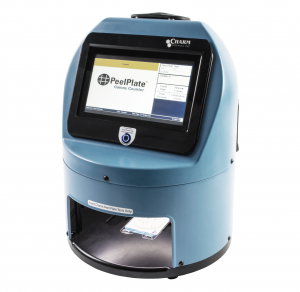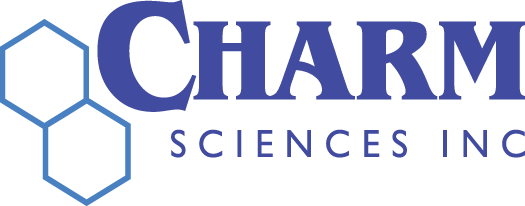Peel Plate Colony Counters
Quickly and Accurately Count and Document Microbial Colonies

Peel Plate Colony Counter II
The Charm Peel Plate Colony Counters are designed to accurately count and document microbial colonies instantly from Peel Plate tests. The Peel Plate Colony Counter is for all 1 mL Peel Plate size while the Peel Plate Colony Counter II is for both the 1 mL and 5 mL Peel Plate sizes.
Both Peel Plate Colony Counter systems operate without a separate computer. Setup is a breeze – just plug it in and it’s ready to go. To analyze a Peel Plate test, simply put the plate into the system and press “Count”. The system takes a picture of the plate and the state-of-the-art image processor accurately counts the colonies – all in under four seconds.
Images, samples, and count results are stored in a secure database, which can optionally be moved to a network providing virtually unlimited storage space. Results are captured in real-time, then exported to an Excel report or set up for direct integration into a LIMS system.
Regular calibration checks help prevent counting errors before they happen. If the system detects an abnormality with the plate, such as large colonies, an alert will notify the user. Calibration accuracy may be enhanced with adjustable settings for size, color, smoothing, and brightness.
Both the Peel Plate Colony Counter and Peel Plate Colony Counter II come with a wireless keyboard/mouse. The optional barcode and QR scanners simplify organizing and querying test results.
Count Screen
1. Login with unique Operator ID and password
2. Select plate size (Peel Plate Colony Counter II only)
3. Select plate type
4. Select matrix channel
5. Count Plate
Counting Options and Features
Peel Plate Colony Counters can be set to:
- Require sample ID
- Apply accounting rounding rules
- Estimate counts according to microbial counting convention
- Greater than maximum count with TNTC and less than 1 for 0 counts
- Display table fields on Count allowing editable dilution, notes, and manual count override.
- Auto increment from sample number and start count on enter key
Results Review
- Review test results including counted image and stored data (Sample ID, Operator ID, Date and Time, Count, Dilution, CFU/g, Note/Error if applicable)
- Images may be enhanced (zoomed) to see circled (counted) colonies
- Download in real time or export one day, week, month, or all current saved test results to a single spreadsheet for easy data management.
Sample ID Barcoding
- QR Sample ID
QR scans are a type of 2D barcode that both Peel Plate Colony Counter systems can automatically scan as part of the counting process – simply insert the Peel Plate test and press ‘Count’. The system automatically files the Sample ID along with the test result. This streamlines the time it takes to enter a Sample ID and reduces operator error in the Sample ID entry. - External Barcodes (available for all 1 mL Peel Plate size)
Both Peel Plate Colony Counter systems also accommodate an external USB barcode scanner for use with printed barcodes that are generated by the end-user. Barcode scanning streamlines the time it takes to enter a Sample ID and reduces operator error in the Sample ID entry. These types of barcodes are more prevalent than QR scanning.
Benefits
- Calculates results in under four seconds
- Compatible with all 1mL Peel Plate tests (Aerobic Count, Coliform, E.coli/Coliform, Enterobacteriaceae, Heterotrophic, Yeast and Mold, Staphylococcus Aureus). Has robust data tracking and analysis for improved documentation
- Accurate and customizable with unique channels programmed for product types
- Secure with individual Operator ID and passwords to protect data integrity
- Self-contained – no additional computer needed for collecting data
Industries
Environmental Monitoring
Contact Sales
Have a sales question? Send us a message and a sales representative will contact you.
By submitting your information via this form, you give Charm Sciences permission to contact you via email about updates, news, or offers that may interest you. It is Charm Sciences’ policy not to share any personally-identifying material obtained through our websites with any third party.
